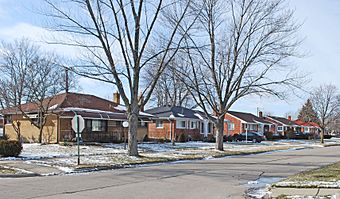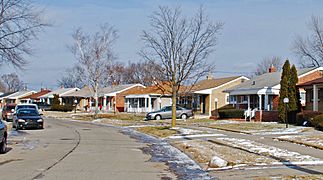Annapolis Park Historic District facts for kids
Quick facts for kids |
|
|
Annapolis Park Historic District
|
|

Looking east on Hanover
|
|
| Location | Julius, Matthew, Hanover, Farnum, Alan, and Paul, Westland, Michigan |
|---|---|
| Area | 71 acres (29 ha) |
| Built | 1953 |
| Architectural style | Modern Movement |
| NRHP reference No. | 06000405 |
| Added to NRHP | May 18, 2006 |
The Annapolis Park Historic District is a special neighborhood in Westland, Michigan. It includes streets like Julius, Matthew, Hanover, Farnum, Alan, and Paul. This area covers about 71 acres (290,000 m2) and has 354 buildings. It was added to the National Register of Historic Places in 2006. This means it's an important place in history!
Contents
A New Home for Families
During World War II, many African-American families moved to Detroit. However, it was hard for them to find good places to live. This was because of unfair rules and high rents. To help with this problem, two people named Julius and William Schwartz decided to create a new neighborhood.
Building Annapolis Park
They planned the Annapolis Park area in what was then Nankin Township. This area is now part of Westland. They specifically designed it for African-American families. The neighborhood was built in a few stages:
- The first part was planned in 1953.
- The second part was planned in 1954.
- The third part was planned in 1955.
A fourth section was planned later in 1961, but it is not part of the historic district.
Helping Families Buy Homes
Local banks were sometimes unwilling to give home loans to these families. So, the Schwartzes started their own company, the Franklin Mortgage Company. This company helped people get the loans they needed to buy houses in Annapolis Park.
A Growing Community
Annapolis Park quickly became very popular. The first two houses were built in 1953. Then, 134 more were built in 1954. Another 168 houses were finished in 1955. By 1956 and 1957, 51 more houses were built, filling up the neighborhood. Many of the first homeowners were likely World War II veterans. They used a special program called the GI Bill to help them buy their homes.
Most homes were sold by word of mouth. But some people, like Jimmy Nelms and Levi Jackson, also helped. Jimmy Nelms was the first African American male school teacher in the Wayne school system. Levi Jackson was a famous football captain from Yale. Their efforts helped many families find homes here.
Community Spirit
In 1955, the residents of Annapolis Park formed a group called the Southeast Homeowners Association. This group helped bring the community together. Today, it's known as the Southeast Westland Homeowners Association. In 1966, the city of Westland was officially formed. Annapolis Park became a part of this new city. Today, Annapolis Park is a lovely neighborhood. Many families who live there are descendants of the first homeowners.
What Annapolis Park Looks Like
Annapolis Park has 354 houses. They are built along streets that curve gently. Most of the houses are "ranch houses." This means they are usually one story tall. Most of them have brick on the outside. They were all built between 1953 and 1957.
House Styles and Layout
The lots for the houses are about 50 to 60 feet wide. They are also about 110 to 140 feet deep. Because the streets curve, the lots are sometimes a little uneven. Even though the houses are similar in size, the curving streets and different roof styles make the neighborhood look interesting.
The streets are paved, and there are sidewalks. There's also a grassy area between the sidewalk and the street. When the neighborhood was first built, maple trees were planted in these grassy areas. Many of these trees are still there today. The whole neighborhood is mostly flat and shaped like an "L." It's surrounded by other neighborhoods, some built around the same time and some newer.
Details of the Homes
There is one older brick house in the district. It was built before the neighborhood was planned. All the other houses are one-story ranch homes. They usually have two or three bedrooms. Their roofs are either "hipped" (sloping on all sides) or "side-gabled" (sloping on two sides).
Most of the houses are made of brick. The bricks are usually red. But some houses have orange-red, buff, or grayish bricks. Many homes also have stone or different colored brick used for decoration. This is often seen above the windows or in special panels. Most houses have garages that are separate from the main house. These garages are usually located at the back of the lot.
- Street scenes





